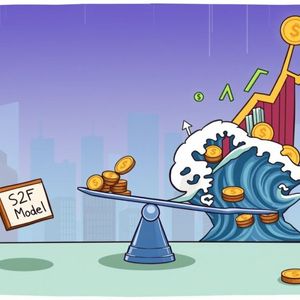BitcoinWorld Bitcoin S2F Model: Why This Beloved Prediction Tool Is Dangerously Flawed The Bitcoin S2F model has long been a fascinating, and often cited, tool for predicting the cryptocurrency’s future price movements. However, in today’s rapidly evolving market, is this scarcity-driven model still a reliable compass for investors? Bitwise , a leading crypto asset manager, suggests it might be dangerously flawed, urging caution and highlighting a critical oversight: the surging demand from institutional players. Understanding the Bitcoin S2F Model: A Quick Look For years, the Stock-to-Flow (S2F) model has captivated the crypto community. At its core, the Bitcoin S2F model attempts to quantify Bitcoin’s scarcity by comparing its existing supply (stock) with the rate at which new Bitcoin is produced (flow). This model gained popularity due to its historical correlation with Bitcoin’s price, particularly around the halving events that reduce the “flow” of new coins. It essentially treats Bitcoin like a precious commodity, such as gold or silver, where scarcity is a primary driver of value. The model suggests that as Bitcoin becomes scarcer post-halving, its price should theoretically increase significantly. It’s a supply-side narrative, focusing almost exclusively on the programmed issuance schedule of Bitcoin. The Critical Flaw: Why Bitcoin ETF Demand Matters More According to André Dragosch , Head of Research for Europe at Bitwise, the primary limitation of the Bitcoin S2F model in the current cycle is its exclusive focus on supply. He argues that this narrow view completely ignores the demand side of the equation, which has become an overwhelmingly powerful force in the market. Dragosch emphasized that while the halving reduces supply, the sheer volume of institutional interest, particularly through vehicles like spot Bitcoin ETFs, is now dwarfing that supply shock. Consider these points: The S2F model predicts a peak price of $222,000 for BTC this cycle, based purely on scarcity. However, institutional demand, largely fueled by newly launched Bitcoin ETFs , now exceeds seven times the annual supply reduction caused by the halving. This creates a massive imbalance that the traditional S2F model simply cannot account for. Ignoring such a significant demand influx means the model might be providing an incomplete, or even misleading, picture of Bitcoin’s true price potential and trajectory. Unpacking the Impact of Institutional Interest on Bitcoin’s Price The advent of spot Bitcoin ETFs in major markets has been a game-changer. These investment vehicles provide a straightforward, regulated, and accessible way for traditional financial institutions and retail investors to gain exposure to Bitcoin without directly holding the asset. This ease of access has unlocked unprecedented capital flows into the cryptocurrency market. The demand created by these ETFs isn’t just significant; it’s transformative. It represents a fundamental shift in market dynamics, moving beyond the niche retail adoption that characterized earlier cycles. Now, large institutional players, pension funds, and wealth managers can allocate capital to Bitcoin, creating sustained buying pressure that far outweighs the incremental supply reduction from the halving. This institutional adoption fundamentally alters the supply-demand equilibrium that the Bitcoin S2F model relies upon. Navigating Bitcoin Price Predictions: Beyond the S2F Model Given the new market realities, what does this mean for investors looking to predict Bitcoin’s price? It’s clear that relying solely on the Bitcoin S2F model is no longer sufficient. A more holistic approach is essential, incorporating a broader range of metrics and market forces. Investors should consider: Institutional Inflows: Track data on Bitcoin ETF holdings and daily net flows. Macroeconomic Factors: Global interest rates, inflation, and economic stability. Regulatory Developments: New laws or policies affecting cryptocurrency. Technological Advancements: Updates to Bitcoin’s network or broader crypto innovation. By integrating these demand-side indicators with traditional supply-side analysis, investors can develop a more robust and accurate understanding of Bitcoin’s potential future price action. In conclusion, while the Bitcoin S2F model offered valuable insights into scarcity in previous cycles, the market has undeniably matured. The overwhelming demand generated by institutional vehicles like Bitcoin ETFs has fundamentally reshaped the landscape. As Bitwise’s research compellingly argues, ignoring this demand is a critical oversight. For those navigating the exciting world of Bitcoin, a nuanced perspective that embraces both supply and, crucially, demand, is paramount for informed decision-making. The future of Bitcoin’s price will be written not just by its scarcity, but by the powerful hands of institutional adoption. Frequently Asked Questions (FAQs) Q1: What is the primary limitation of the Bitcoin S2F model according to Bitwise? A1: The primary limitation is its exclusive focus on Bitcoin’s supply reduction from halvings, completely ignoring the significant and growing demand side, particularly from institutional investors via ETFs. Q2: Who is André Dragosch ? A2: André Dragosch is the Head of Research for Europe at Bitwise , a prominent cryptocurrency asset management firm. He is known for his insights into crypto market dynamics. Q3: How do Bitcoin ETFs impact Bitcoin’s price? A3: Bitcoin ETFs provide an accessible and regulated avenue for institutional and traditional investors to gain exposure to Bitcoin, generating massive demand that can significantly drive up its price, often exceeding the supply reduction from halvings. Q4: What was the Bitcoin S2F model’s peak price prediction for BTC this cycle? A4: The S2F model predicts a peak price of $222,000 for Bitcoin this cycle, based purely on its scarcity metric. Q5: What other factors should investors consider for Bitcoin price prediction? A5: Beyond the S2F model, investors should consider institutional inflows (especially from ETFs), macroeconomic factors, regulatory developments, and technological advancements within the crypto space. If you found this analysis insightful, please consider sharing it with your network! Your support helps us bring more critical perspectives on cryptocurrency market trends to a wider audience. Join the conversation and help others understand the evolving landscape of Bitcoin investment. To learn more about the latest Bitcoin trends, explore our article on key developments shaping Bitcoin price action . This post Bitcoin S2F Model: Why This Beloved Prediction Tool Is Dangerously Flawed first appeared on BitcoinWorld .















